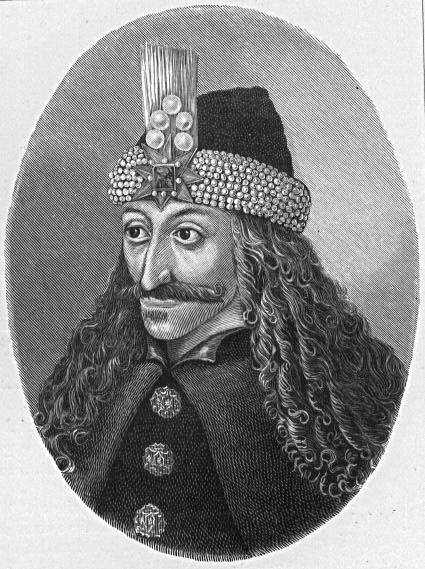
(Vlad III Drăculea, Vlad Țepeș 1431 - 1476)
Without any doubt, the most famous Romanian of the Middle Ages is Vlad the Impaler. He was born in late 1431 in Sighisoara. That same year, his father Vlad II was appointed to the Order of the Dragon by the Holy Roman Empire. Being proud of this fact, he added the epithet Dracul which is derived from the Latin word draco meaning dragon, while in the Romanian language the word drac means devil. However, his son is remembered as Vlad the Impaler. He became infamous for his cruelty that he showed towards his enemies and those who were opposed to his ideas and decisions. Although he used different kinds of punishment in these cases, it is far known that his favorite was impalement. Hence the nickname Tepes – Impaler (țeapă in Romanian language means pole). Historians see Vlad’s cruelty as a result of his stay among the Ottomans. He and his brother Radu spent six years among them, since their father gave them away as pledge to Sultan Murad II. However, it should be noted that atrocities such as cutting heads, sales people and burning of so-called witches occurred throughout Europe in the Middle Ages, while impalement was typical for the Ottomans.
It is known that Vlad the Impaler ruled Wallachia three times. The first arravial to the throne took place in 1448, but it is little known in history, because of its short duration. Unlike the first one, the most important and the most successful was a six-year reign between 1456 and 1472. In that time, Vlad was opted for the authoritarian power, where the ruler has priority over the nobility. The principles of his government program included the drastic measures against theft, promoting of hard work and punishing slackers, as well as maintaining the fair trade. The feudal obligation was abolished and all those who wanted to fight were given the status of free soldier. He also introduced the first known program for the integration of the Romani through their participation in the fight against the Ottomans. He was a benefactor of the Hilandar Monastery. In addition to military campaigns, one of the most important aspects of his reign was the foreign policy. Vlad was aware of the status of Wallachia, which temporarily gained independence from the Ottoman Empire during his reign.
In 1459, the news that Serbia had become pashadom upset the Vlach boyars who did not want that to befall their country, because pashadom meant the loss of all the privileges and aristocratic estates, therefore they decided for the fight against the Ottomans. At that time, Pope Pius II organized a crusade against the Ottoman Empire, in which Vlad led battles south of the Danube. During one march in the winter of 1461, 23 800 of enemy soldiers were, allegedly, killed. Since Christian Europe welcomed this with gratitude, all over the continent in churches rang bells in honor of this army leader. When Sultan Mehmed II the Conqueror tried to reach the town of Targovishte, Vlad was burning land, poisoning wells, making marshy terrains and setting traps in order to make his attack more difficult. Furthermore, he was sending people suffering from tuberculosis, syphilis, leprosy, plague among the Ottomans to infect them. Nevertheless, the most memorable moment of the fight was a "Night Attack" on June 17, 1462. Around midnight, Vlad attacked the Ottoman camp with several thousand soldiers and killed, apparently, more than 15 000 Ottoman soldiers.
Shortly after these events, Vlad's brother Radu ΙΙΙ the Handsome came to the throne since he managed to persuade the boyars to his side. Vlad found salvation in Transylvania, at that time ruled by King Matthias Corvinus. The King sent Vlad to the fortress on the Danube, where he was captured for twelve years. During this time, he attracted the attention of Matthias' sister, so the imprisonment conditions were milder and in 1474 were completely abolished. He came to Wallachian throne for the third time two years later, but not for long.
In December 1476, Vlad lost his life. This event is to this day shrouded in legends and mysteries. There are several versions of his death. According to one, he was killed in a battle near Bucharest. According to another, his soldier speared him because he didn’t recognize him being masked as enemy. The third says that he was killed by boyars. It was believed for a long time that he was buried in the monastery of Snagov. There is also a statement that his body was found in the monastery of Comana or in its vicinity, while recent studies show that the place of his death and the grave is city of Naples in Italy.
Wherever he rested, Vlad the Impaler, this "Grand Master", as he liked to being called, was and will remain the pride of his people, a hero and a brave warrior who protected his country and fought for its well-being.
Prepared by: Nataša Sparić

